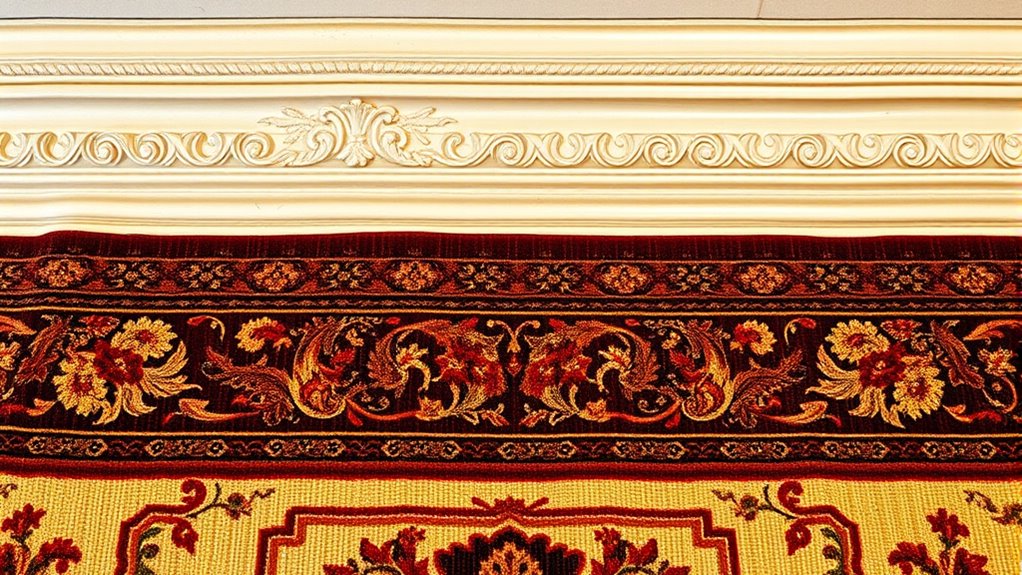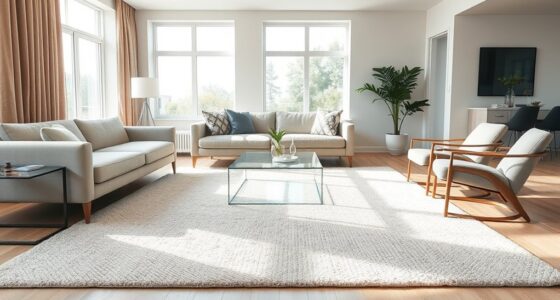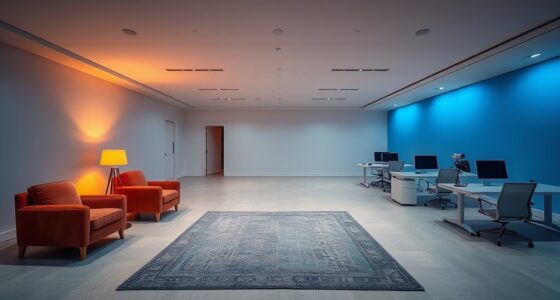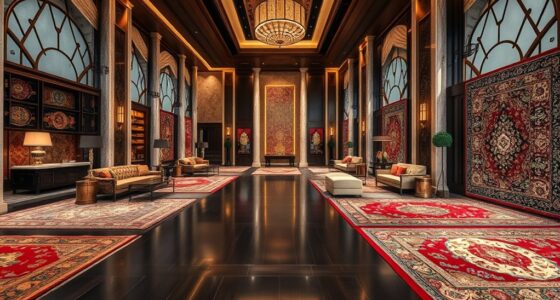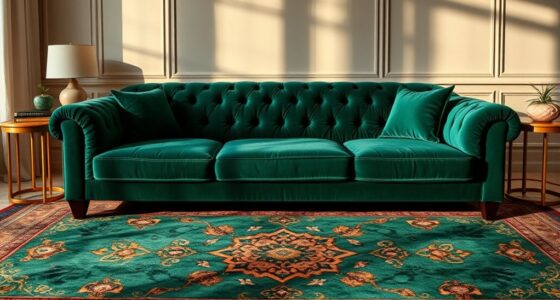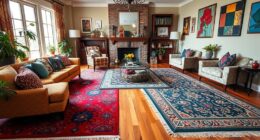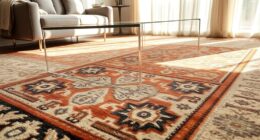To match rug borders to architectural mouldings, focus on harmonizing textures, patterns, and proportions. Choose borders that echo the style and scale of your mouldings—sleek for modern spaces or ornate for traditional ones. Use similar finishes and complementary colors to create visual cohesion. Balance the size and placement to assure a seamless flow between the rug and architectural details. If you want to master these strategies, you’ll discover more inside.
Key Takeaways
- Match border styles and widths with the room’s moulding profiles for visual harmony.
- Coordinate color palettes between rug borders and architectural mouldings to create cohesive aesthetics.
- Select textures and finishes that complement or subtly contrast for a seamless look.
- Ensure proportions of rug borders are slightly smaller than mouldings to maintain balanced visual flow.
- Incorporate pattern elements that echo architectural motifs, such as geometric or floral designs, for unity.
Understanding the Different Types of Rug Borders and Mouldings
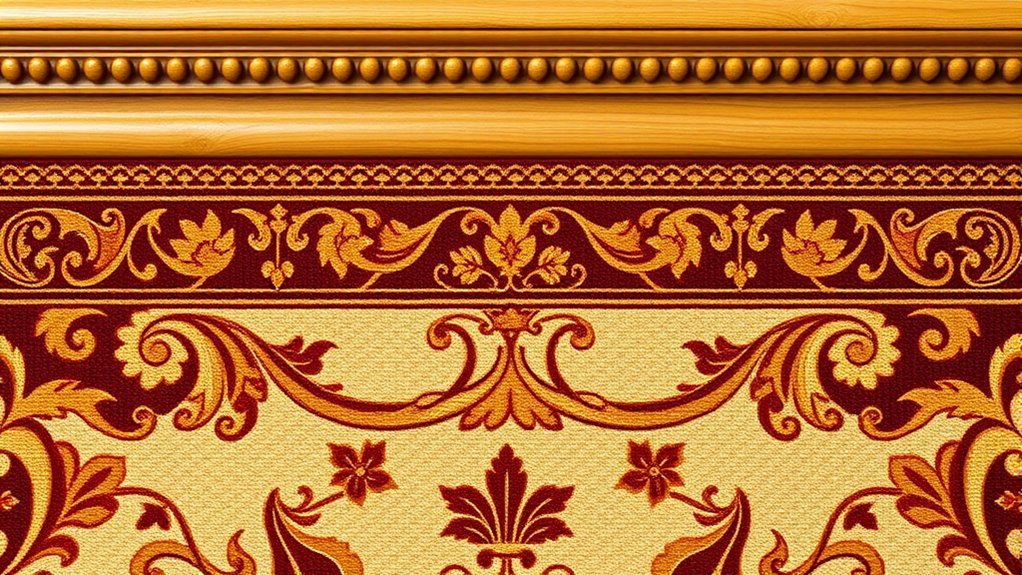
Understanding the different types of rug borders and mouldings is essential when aiming for a cohesive design. You should recognize that border styles vary from simple, narrow bands to elaborate, wide frames, each creating a different visual impact. Moulding profiles also differ, with options like beveled, rounded, or stepped edges, influencing how the rug interacts with the space. When selecting border styles, consider how they complement or contrast with your moulding profiles in the room. For example, a sleek, minimal border pairs well with modern mouldings, while ornate, decorative borders suit traditional mouldings. Knowing these distinctions helps you choose rug borders that harmonize with your architectural features, ensuring a unified and polished look throughout your space. Additionally, understanding self watering plant pots can inspire interior design choices that enhance the overall aesthetic and functionality of your living environment.
How to Identify Your Room’s Architectural Style
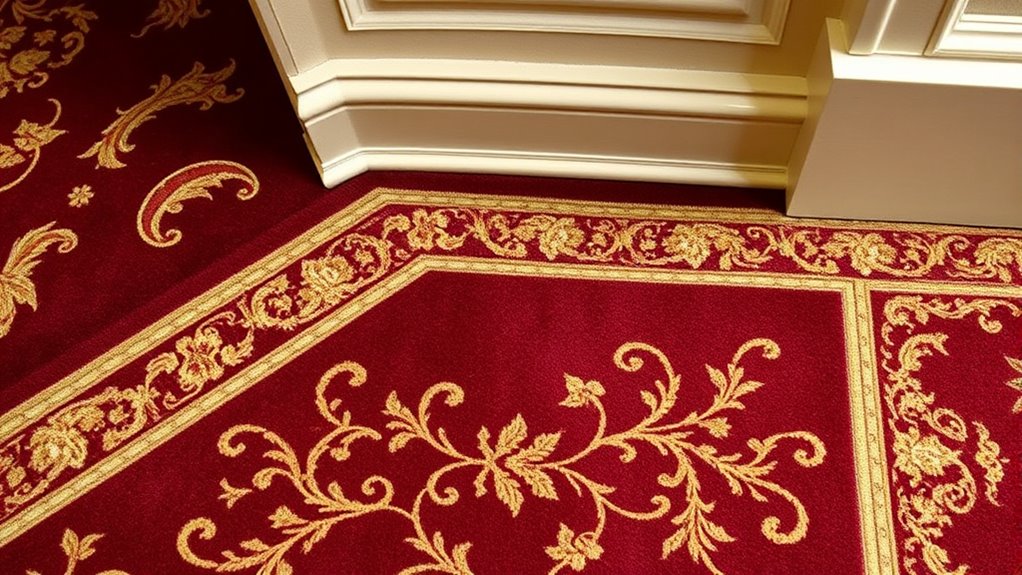
To identify your room’s architectural style, start by observing key design elements such as moldings, window and door trims, ceiling details, and overall proportions. These features reveal much about the room’s historical influences and regional styles. For example, ornate crown moldings and decorative plasterwork often indicate Victorian or Baroque origins, while simple, clean lines suggest modern or minimalist designs. Pay attention to the materials and craftsmanship, which can also hint at the era and region. Look for distinctive characteristics like rounded arches, intricate carvings, or flat surfaces. Recognizing these details helps you determine whether your space aligns with traditional, colonial, craftsman, or contemporary styles, guiding your choices for borders and mouldings that complement your room’s unique personality. Additionally, understanding the architectural details of family photoshoot fails can inspire playful, memorable accents that reflect your space’s character.
Choosing a Color Palette That Harmonizes Borders and Mouldings
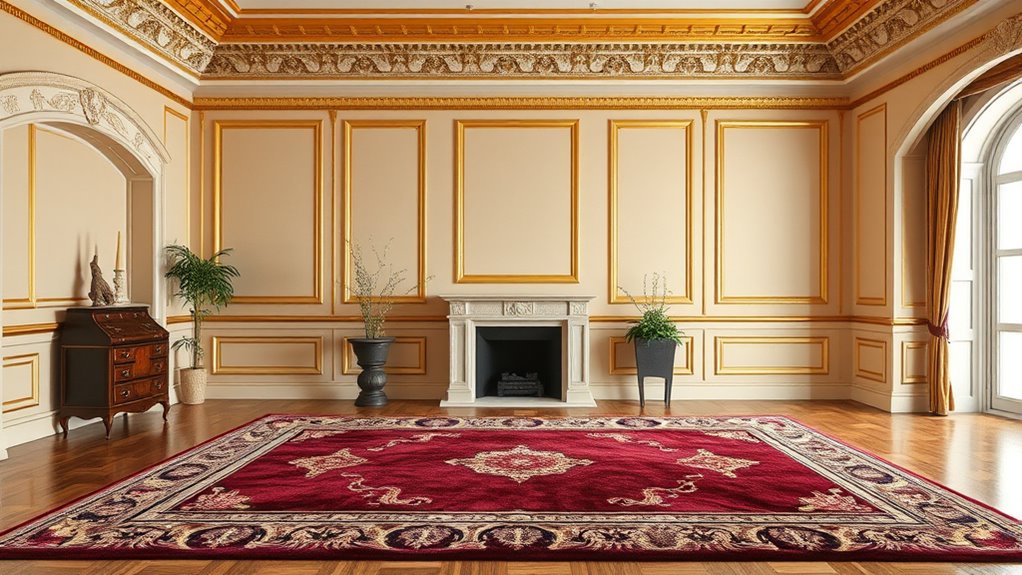
You want your rug borders and mouldings to work together seamlessly, so start by coordinating wall and border hues. Choosing colors that complement your moulding tones will create a balanced, cohesive look. Pay attention to how these shades interact to enhance your room’s overall style. Incorporating color harmony principles can help you select palettes that naturally blend and elevate your space. Additionally, considering the visual impact of contrasting or matching tones can further refine your design choices. Embracing a curiosity about design trends can also inspire innovative and harmonious pairing options. Recognizing how color schemes influence the atmosphere can help you make more informed decisions and achieve a truly unified design. Understanding color psychology can further refine your choices to evoke specific moods and feelings in your space.
Coordinating Wall and Border Hues
Choosing a cohesive color palette for your walls and borders is essential to creating a harmonious look that complements your architectural mouldings. When selecting hues, consider how fabric textures and border styles influence the overall feel. Opt for shades that either match or subtly contrast to enhance depth and interest. For example, soft, muted tones work well with intricate border styles, while bolder colors can highlight architectural details. To elevate the sophistication, think about integrating subtle variations in hue, such as using a slightly darker or lighter shade of your moulding color. This approach creates a seamless progression. Remember, the goal is to unify your space while allowing the architectural elements to stand out naturally. Incorporating color harmony principles can further refine your selections and ensure a balanced aesthetic.
Complementing Moulding Tones
Building on the idea of coordinating wall and border hues, selecting a harmonious color palette for your mouldings and borders can truly elevate your space. Consider your furniture style when choosing tones—sleek, modern pieces pair well with crisp, monochromatic shades, while traditional furniture complements warmer, richer hues. Your window treatments also influence your palette; light fabrics work best with softer, neutral tones, while bold drapes can handle deeper, contrasting colors. Color coordination is essential for creating a seamless flow between borders and mouldings, ensuring a cohesive look. Aim for colors that flow seamlessly from borders to mouldings, creating unity. Subtle variations in tone add depth without overwhelming the room. Ultimately, your goal is to achieve a balanced look where borders and mouldings enhance, rather than compete with, your overall decor. Attention to detail in your color choices can make a significant difference in the overall harmony of your design. Incorporating color harmony principles can also inspire unique color pairings that reflect personal style and personality traits.
Matching Material Finishes for a Cohesive Look

Achieving a cohesive look in your space hinges on matching the finishes of your rug borders and architectural mouldings. Consider fabric textures that complement each other, creating visual harmony and tactile interest. Additionally, pay attention to material durability, ensuring both elements withstand daily wear without compromising style. To elevate sophistication, think about:
- Selecting finishes with similar sheen or matte qualities
- Coordinating subtle color undertones across materials
- Using complementary textures that add depth without clashing
- Considering durability to ensure both elements maintain their appearance over time
Matching finishes isn’t just about color; it’s about creating a seamless flow through consistent material choices. When fabric textures and durability align, your space feels intentional and well-designed, elevating the overall aesthetic and ensuring longevity. Incorporating material compatibility can further enhance the cohesive effect, making your design both beautiful and durable, especially by understanding how home essentials like mouldings and textiles work together to create a unified look.
Balancing Scale and Proportion in Design Elements
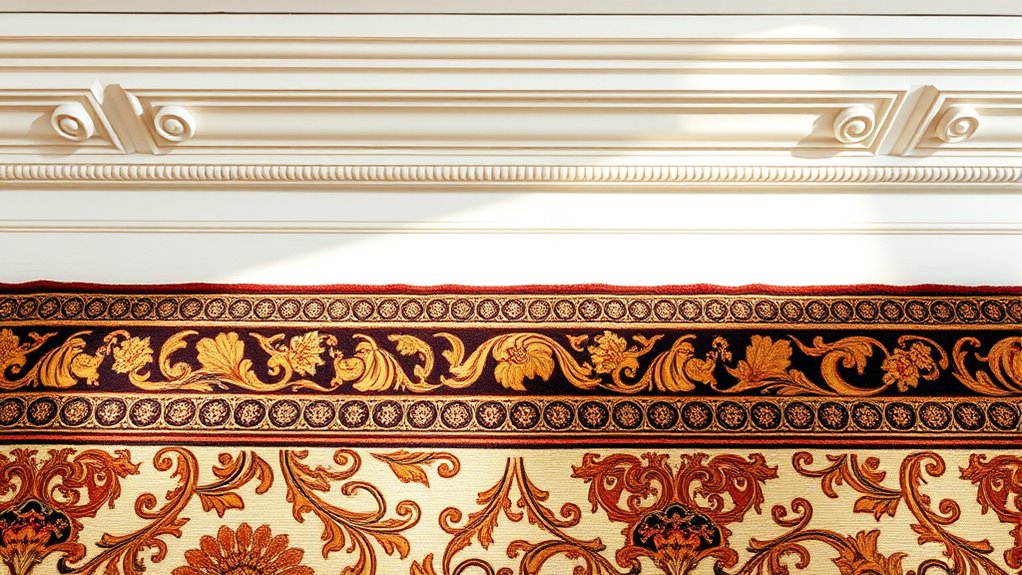
When coordinating finishes and textures, it’s also important to contemplate how the scale and proportion of each design element interact within the space. Achieving scale harmony ensures that your rug borders and architectural mouldings complement rather than compete. Proportion balance keeps elements visually appealing and cohesive. To guide your choices, consider this table:
| Element | Scale Consideration | Proportion Balance |
|---|---|---|
| Rug Border | Slightly smaller than mouldings | Match width to room height |
| Wall Mouldings | Not overpowering furniture | Keep height proportional to wall height |
| Accessories | Subtle, not overwhelming | Maintain visual weight harmony |
Additionally, understanding visual hierarchy can help in arranging elements so that each component contributes to a balanced and harmonious design. Recognizing the contrast ratio in your design details can further enhance visual interest and clarity within the space.
Creating a Visual Flow With Complementary Patterns and Textures
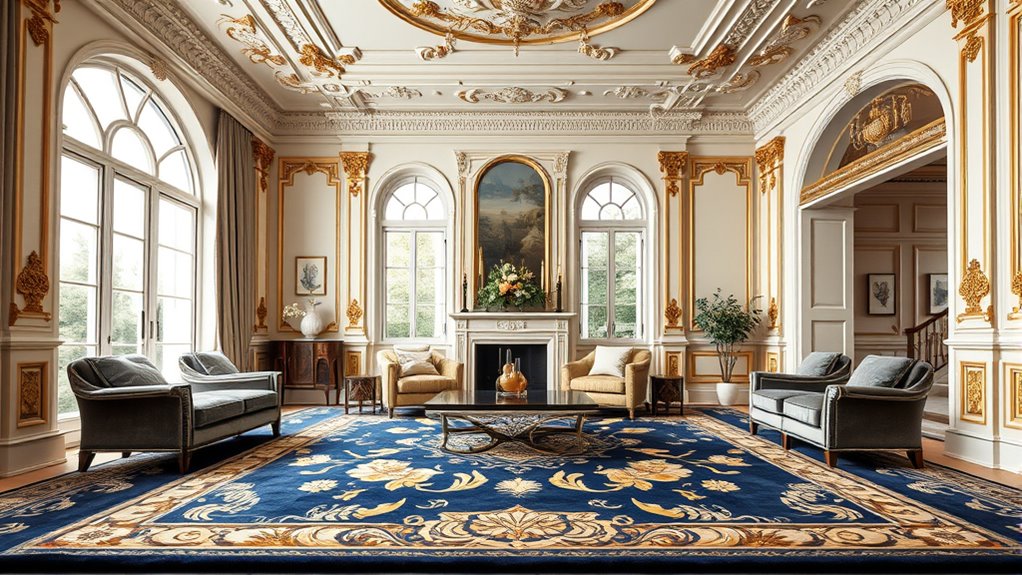
To create a seamless visual flow, you need to harmonize patterns and shapes within your space. Balancing contrasting textures adds depth without overwhelming the design. When you combine these elements thoughtfully, your rug borders and architectural mouldings will work together effortlessly.
Harmonizing Patterns and Shapes
Creating a seamless visual flow between rug borders and architectural mouldings relies on selecting patterns and textures that complement each other. To achieve this, focus on harmonizing shapes and motifs to create a cohesive look. Incorporate geometric motifs that echo the clean lines of mouldings, establishing a sense of order and balance. Floral patterns can soften sharp angles, adding elegance and organic movement. Consider repeating shapes or motifs across both elements to unify the design. Contrast can be subtle but effective, like pairing intricate floral borders with simple mouldings.
- Use geometric motifs that mirror the angles and lines of mouldings
- Integrate floral patterns to add softness and visual interest
- Match the scale of patterns to maintain proportion and harmony
Balancing Textural Contrast
Balancing textural contrast between rug borders and architectural mouldings enhances the overall harmony of a space. By carefully choosing textures that differ yet complement each other, you create tactile differentiation that guides the eye smoothly across the room. For example, pairing a richly textured rug border with sleek, smooth mouldings adds depth without overwhelming. This contrast draws attention to the details, creating a visual flow that feels intentional and cohesive. You want to avoid clashes by selecting patterns and textures that share a common tone or subtle element. When done right, this balance highlights each feature’s unique qualities while uniting the space. Remember, tactile differentiation is key to achieving a dynamic, yet harmonious, environment where textures work together seamlessly.
Incorporating Accent Colors for Subtle Coordination
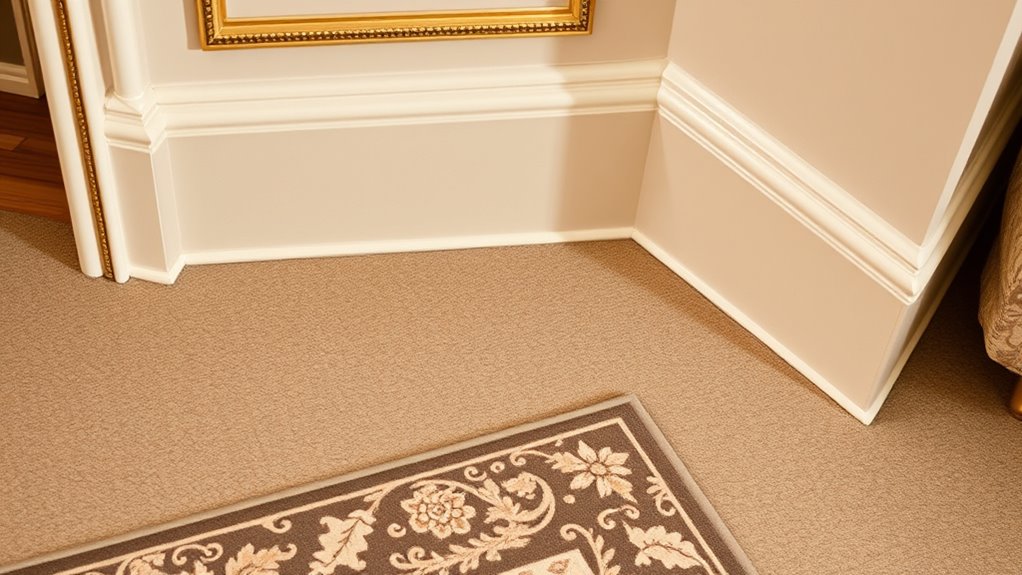
Incorporating accent colors into your rug border can subtly enhance the overall harmony of your space. By thoughtfully selecting accent color accents, you create a cohesive look that ties the rug to surrounding architectural features. Focus on subtle hue integration to avoid overpowering the room’s design. This approach allows the border to complement rather than compete with mouldings and walls. To elevate sophistication, consider these strategies:
- Use a muted tone from your room’s palette as an accent to maintain understated elegance
- Incorporate small pops of color through accessories that match your rug’s border accents
- Opt for a monochromatic scheme with slight variations for a seamless, refined look
This method ensures your rug border harmonizes effortlessly with your architectural details.
Tips for Transitioning Between Different Architectural Elements
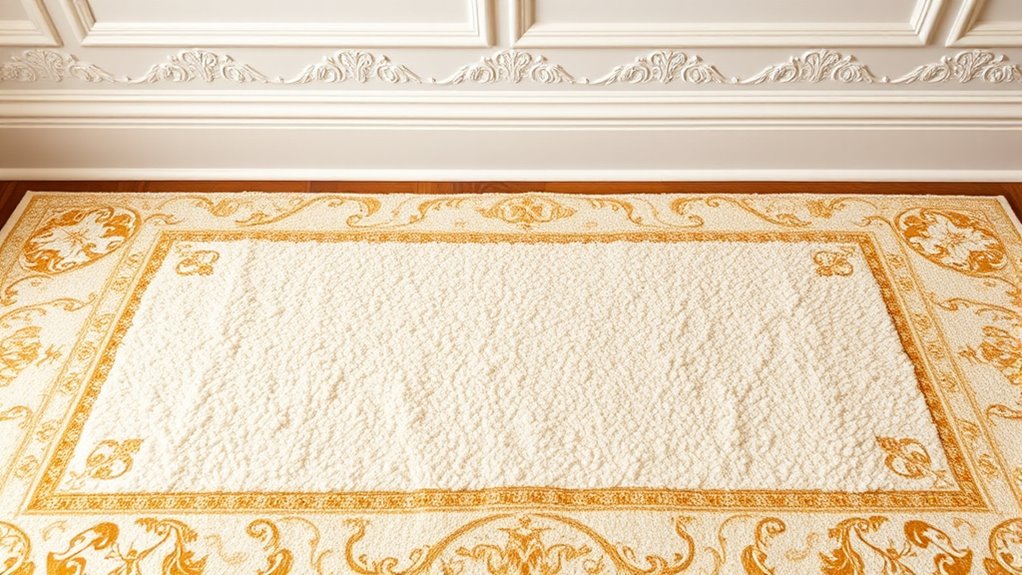
When shifting between different architectural elements, careful planning guarantees a seamless flow throughout your space. Start by selecting decorative rug trims that complement the mouldings, creating visual continuity. Use moulding installation techniques that align and match the profiles of different elements, ensuring smooth progressions. Pay attention to the height and scale of each moulding to avoid abrupt changes. When borders meet, consider overlapping or tapering them for a more natural connection. Consistent color schemes or subtle contrasts can also help unify diverse architectural features. Precise measurements and patience during installation are key, preventing gaps or misalignments. Overall, thoughtful coordination and attention to detail will help you achieve a polished, harmonious look across your room’s varying architectural styles.
Using Lighting to Highlight and Enhance Design Details

Lighting plays a crucial role in showcasing your architectural details and rug borders, transforming a standard space into a visually stunning environment. By using strategic lighting techniques, you can emphasize intricate mouldings and borders, creating depth and dimension. Accent lighting is particularly effective, drawing attention to specific design elements and highlighting their craftsmanship. To maximize impact, consider the following approaches:
- Employ wall-mounted fixtures or adjustable spotlights to cast focused illumination on key features.
- Use dimmers to control light intensity, enhancing the ambiance and drawing subtle attention to details.
- Experiment with color temperature, such as warm tones, to complement the materials and create a cohesive look.
These lighting techniques elevate your space’s aesthetic, ensuring your design details are both noticed and appreciated.
Frequently Asked Questions
Can Rug Borders Match Multiple Architectural Styles Within One Room?
Yes, rug borders can match multiple architectural styles within one room. You can explore various decorative border options that complement different styles by using color coordination strategies. For example, choose borders with subtle hues for a modern look and more intricate designs for traditional elements. Balancing these choices guarantees your rug enhances the room’s overall aesthetic, creating a harmonious blend that connects diverse architectural features seamlessly.
How Do I Maintain Consistency if My Room Has Mixed Moulding Profiles?
When your room has mixed moulding profiles, you can maintain consistency by focusing on color coordination and material compatibility. Choose rug borders that complement the hues of your mouldings, creating visual harmony. Opt for materials that match or blend well with your moulding finishes, like wood or painted surfaces. This approach helps unify the space, even with varied profiles, ensuring your decor feels cohesive and thoughtfully curated.
Are There Universal Rug Border Styles That Suit All Architectural Types?
You ask if universal border styles suit all architectural types. While no single style fits every space, you can choose borders with versatile designs like simple bands or subtle patterns. These options offer border design compatibility across diverse architectural styles. By selecting timeless, neutral borders, you guarantee your rug complements various moulding profiles, creating a cohesive look. Focus on understated elegance to achieve harmony in mixed architectural environments.
How Often Should I Update or Change Rug Borders to Stay Current?
Thinking timefully about your rug borders’ look, you should update them seasonally or as styles shift. Trend tides change, so staying current means swapping borders when seasonal trends emerge or when durability considerations demand a refresh. Usually, every few years works well, but trust your eye. Keep your space fresh and fashionable by frequently evaluating whether your borders still blend beautifully with your evolving décor.
What Are Common Mistakes to Avoid When Pairing Rug Borders With Mouldings?
When pairing rug borders with architectural mouldings, avoid common mistakes like pattern clashes and color mismatches. You might think matching everything perfectly is best, but it can create a cluttered look. Instead, choose borders that complement your mouldings’ style and color palette. Be subtle with patterns, and guarantee the hues coordinate well. This approach creates harmony and enhances your space without overwhelming it.
Conclusion
Remember, Rome wasn’t built in a day, and perfecting your rug borders and mouldings takes patience. By paying attention to style, color, and proportion, you create a harmonious space that feels intentional and inviting. Trust your eye, experiment with textures, and don’t be afraid to make subtle adjustments. With time and care, your room will beautifully reflect a cohesive, polished look that’s pleasing to the eye.
